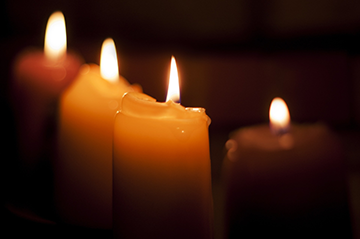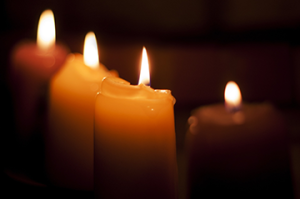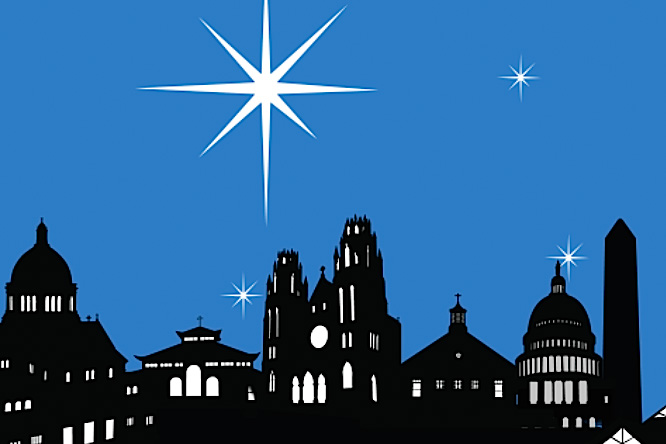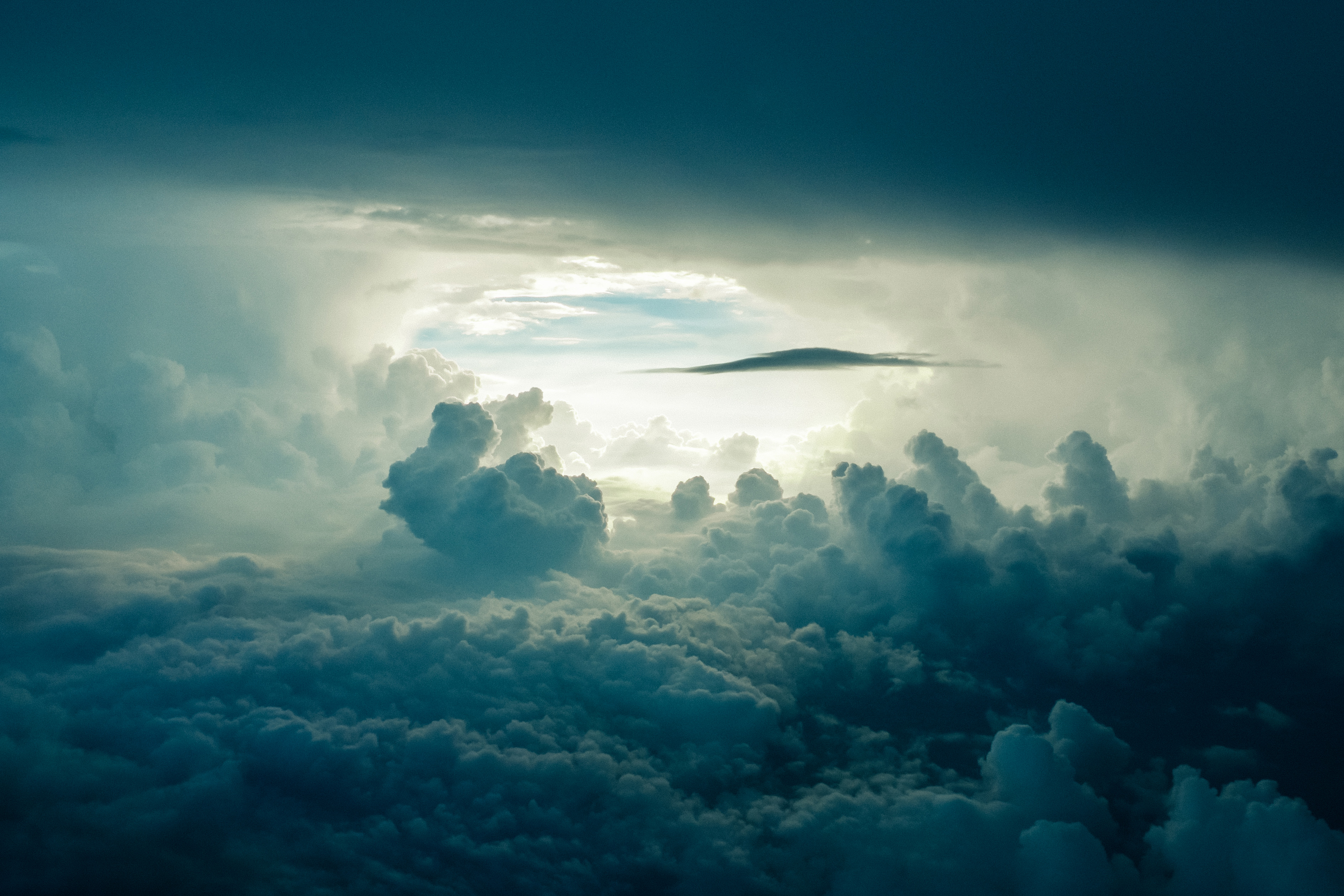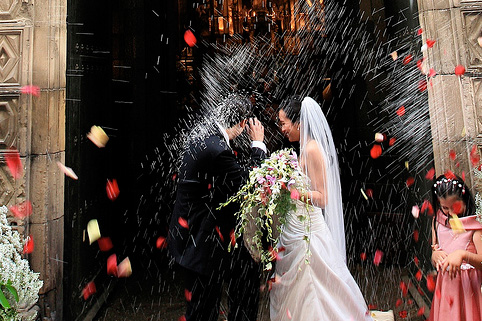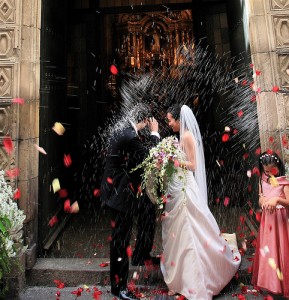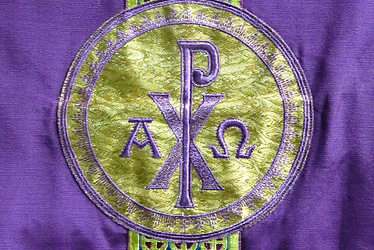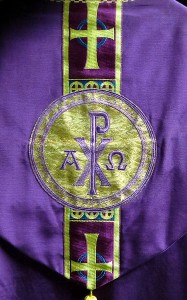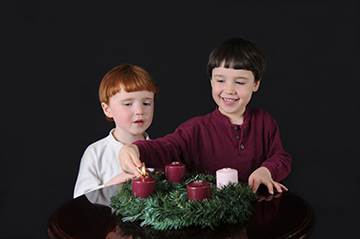 As the Advent season begins, we are immediately drawn into its principle theme of preparation and readiness for the coming of the Lord. The first coming of the Lord has already been fulfilled at Bethlehem. And while we should prepare spiritually for the coming Christmas Feast, these first weeks of Advent bid us to focus even more on the Second Coming of the Lord in glory.
As the Advent season begins, we are immediately drawn into its principle theme of preparation and readiness for the coming of the Lord. The first coming of the Lord has already been fulfilled at Bethlehem. And while we should prepare spiritually for the coming Christmas Feast, these first weeks of Advent bid us to focus even more on the Second Coming of the Lord in glory.
Thus, as the curtains draw back on the opening scenes of Advent, we are warned by the Lord that He will come on the clouds with great power and glory and that we must be prepared. He says, Be vigilant at all times and pray that you have the strength to escape the tribulations that are imminent and to stand before the Son of Man.
Today’s gospel is taken from the Mt. Olivet discourse. As we saw two weeks ago, the historical context in which the Lord was speaking was not that of the end of the world, but of the destruction of the Temple and of Jerusalem. For those ancient Jews, however, it was the end of the world as they knew it. The destruction of Ancient Jerusalem is also symbolic of the end of the world. The world will end for us either by our own death or by His coming to us in the Second Coming. Whatever the personal context will be for us, the message is the same: be ready!
Let’s study this gospel in two stages, and then heed its message.
I. DOUBLE VISION – The gospel opens with a description of tribulations that are about to come on the land. But in that description there is a twofold reaction that is described. Note first the tribulation that is described and then the first of two reactions that are intertwined with it:
There will be signs in the sun, the moon, and the stars, and on earth nations will be in dismay, perplexed by the roaring of the sea and the waves. People will die of fright in anticipation of what is coming upon the world, for the powers of the heavens will be shaken. And then they will see the Son of Man coming in a cloud with power and great glory.
The political powers will be confused and in dismay. Fixed points in this world such as the sun, moon, stars, sea, and land will be shaken. This will cause many to be frightened, shocked, and bewildered. And thus is described the reaction of one group of human beings.
But not all human beings react in this way. There is a second reaction that is prescribed and described:
But when these signs begin to happen, stand erect and raise your heads because your redemption is at hand.
Yes, this a very different reaction: one of expectant joy and serene confidence. And so we see here a kind of double vision.
- Some cry out with fear and say “He is wrathful!” Others with faith say, “He is wonderful!”
- To some He is frightening, to others He is fabulous.
- To some these events are awful, to others they are awe-inspiring.
- Some shout, “Horror on every side!” Others sing, “Hallelujah to the King of Kings!”
Thus, there is the dread of the defeated and the delight of the delivered.
Of those who experience dread, other Scriptures say,
- Behold, he is coming with the clouds, and every eye will see him, every one who pierced him; and all tribes of the earth will wail on account of him. Even so. Amen (Rev 1:7).
- Then the kings of the earth, the princes, the generals, the rich, the mighty, and every slave and every free man hid in caves and among the rocks of the mountains. They called to the mountains and the rocks, “Fall on us and hide us from the face of him who sits on the throne and from the wrath of the Lamb! For the great day of their wrath has come, and who can stand?” (Rev 6:15-17)
Of those who experience delight, other Scriptures say,
- He who testifies to these things says, “Surely I am coming soon.” Amen. Come, Lord Jesus! (Rev 22:20)
- Come, O Lord! (1 Cor 16:22)
- Behold, I am coming soon! Blessed is he who keeps the words of the prophecy in this book (Rev 22:7).
- He who is coming will come and will not delay. My righteous will live by faith….we are not of those who shrink back and are destroyed, but of those who believe and are saved (Hebrews 10:37, 39).
- In all these things we are more than conquerors through him who loved us (Rom 8:37).
- Surely the day is coming; it will burn like a furnace. All the arrogant and every evildoer will be stubble, and that day that is coming will set them on fire,” says the Lord Almighty. “Not a root or a branch will be left to them. But for you who revere my name, the sun of righteousness will rise with healing in its wings. And you will go out and leap like calves released from the stall (Malachi 4:1-2).
Yes, it is a kind of double vision: two very different experiences of the same reality. The difference, as we shall see, is that between sin and grace, and with which “army” we have allied ourselves.
As an example of this “double vision,” consider the Civil War. As with any war, the issues leading up to it were complex, but it is simply not possible to remove from the mix the egregious injustice and sin of slavery. As the Northern troops swept (often ruthlessly) through the South there were some who saw only destruction and conquest. But there were others who saw something very different. An old spiritual from the time said,
Oh the slave folk say, “Ho! Ho!
And the master says, “Oh No!”
And it must be now that the kingdom’s coming
In the year of Jubilo!
So for some, it was the definitive end to power and the South they knew. To others, it meant vindication and freedom.
In order for us to celebrate on that day when the Lord comes, there are prerequisites that must first be met. And that leads us to the next stage of today’s gospel.
II. DIRECTIVES – The Lord continues on, instructing us in how to be ready for the great and terrible day of the Lord:
Beware that your hearts do not become drowsy from carousing and drunkenness and the anxieties of daily life, and that day catch you by surprise like a trap. For that day will assault everyone who lives on the face of the earth. Be vigilant at all times and pray that you have the strength to escape the tribulations that are imminent and to stand before the Son of Man.
And herein the Lord gives us five basic directives of things to avoid and practices to adopt in order that we be ready and able to greet Him in all His glory. Notice that the Lord announces the effect (drowsiness) and then the causes. This is typical of ancient practice. In modern times, however, it is more common to speak of the causes and then describe the effects. Hence, we will proceed with our study in a slightly different order than that in which it was presented.
1. DEBAUCHERY – In the text, the Lord warns of the problem of “carousing.” The Greek word used is κραιπάλῃ (kraipale), which refers to the giddiness and headache caused by drinking wine to excess. More generally it means the excessive indulgence of all of our passions, or of living life to excess. Other translators render this word as “dissipation,” referring to the general squandering of resources that results from overindulgence.
We, of course, live in times in which our every need is (over)supplied. There is much opportunity for excess. At the market there is not merely bread, there are fifty different types of bread. Our oversupply and overindulgence are literally reflected in our bodies: obesity, diabetes, high blood pressure, high cholesterol, and heart disease plague us.
And it is not just food that is excessive; it is everything. We are excessively busy with the nonessentials of life. There are innumerable ways to occupy our minds. Our minds are so overstimulated that we cannot hear that “still, small voice.” Most people have a very short attention span due to this overstimulation. All day long the noise from the radio, mp3 player, TV, DVD player, CD, PC, iPad, and/or cell phone vies for our attention. It jams our mind and breaks our union with Christ and even with our very self. And then there are the 24-hour news channels generating hype about even ordinary events: “Breaking news!” Our e-mail is flooded with junk mail and spam, offering false hopes, and products and services we don’t really need. There are endless money-making schemes, lotteries, and sweepstakes. And oh, the sales: Black Friday, Cyber Monday, pre-holiday, post-holiday! It makes me think of the carnival hucksters calling, “Step right up!” But it is worse than that because it seems since we cannot get away from it.
We spend, spend, spend and then borrow, borrow, borrow to support our spending. We need two incomes and a 60-hour work week so that we can afford our lifestyle. And once we have acquired “the goods,” we’re never there to enjoy them. We sacrifice family on the altar of pleasure. We have an excess of everything except children, because they cost money and thus impede our ability to consume.
Even our recreation is excessive. Our weekends and vacations often leave us exhausted, disquieted, and unprepared for the coming week. A simple, quiet weekend, reflecting on God’s wonders, or spending time at home with family? No way! It’s off to watch the myriad activities of our overscheduled children. The weekends meant for rest instead feature distinctly unrestful activities such as shopping, dancing in loud bars, watching football games, and drinking.
Yes, it’s all excess. It weighs us down, wearies us, costs a lot of time and money, and isn’t really all that satisfying anyway. It is dissipation. In the end, we are left with something like that headache and hung over feeling of which the Greek word kraipale speaks. But up goes the cry anyway: “More! One more round!” Excess, dissipation, surfeiting, carousing; more, more, more!
2. DIVISIONS – The Lord warns of the “anxieties” of daily life. The Greek word used is μερίμναις (merimnais) meaning more literally “a part separated from the whole,” “that which divides and fractures a person into parts.” And thus we see the human person, overwhelmed with excess, incapable of distinguishing the urgent from the important, the merely pleasurable from the productive. On account of our overstimulation, our excess, we are pulled in many different directions. We can’t decide; our loyalties are divided and conflicting. We are endlessly distracted by a thousand contrary drives and concerns.
Anxiety is the condition of being overwhelmed and divided by many and contrary drives, demands, and priorities. Anxiety freezes and perplexes us. There is too much at stake and no central governing principle to direct our decisions. All of this overwhelms us and clouds our mind and heart. We are anxious about many things and cannot determine the “one thing necessary” that will order all of the details (cf Luke 10:42). This is anxiety and the Lord enumerates it as among those things that destroy our readiness to stand before Him with joy.
3. DRUNKENNESS – Here the Greek word use is very straightforward: μέθῃ (methe), meaning drunk on wine. But why do we drink? Frankly we drink to medicate our anxiety. Overwhelmed by the excess that leads to anxiety (inner division and conflict) we drink to medicate our sense of being overwhelmed. We need something to soothe us. And instead of slowing down and seeking God, we drink. We anesthetize our mind. And it is not only alcohol that we use. We use things, people, power, sex, entertainment, diversions, and distractions; all to soothe our tense, anxious mind.
This of course only deepens the central problem. For all these things only add to the very problem that has disturbed us in the first place: the kraipale that is excess and dissipation. The solution is to get clear about our priorities, to seek God and allow Him to order our life. But instead of seeking a clear mind, we do the opposite and tune out. A little wine is a gift from God (cf Psalm 104:15) to cheer our hearts. But with excess, we go beyond cheer to dull our mind.
To be sober is to have a clear mind, one that knows and is in touch with reality and final ends. To be sober is to be alert, honest, and reasonable; to act in a way that bespeaks thoughtful and deliberate movement toward a rational and worthy goal. The sober person acts consciously and with purpose toward a unifying goal: being with God. St. Paul says, But this one thing I do: Forgetting what is behind and straining toward what is ahead, I press on toward the goal to win the prize for which God has called me heavenward in Christ Jesus (Phil 3:13-14).
Lacking the one unifying thing, torn apart within, and anxious on account of our excesses, we dull our mind with alcohol. The Lord calls us to clarity but we retreat into insobriety. We are, in effect, “hung over” from indulging in the excesses of this world and then “medicating” the resulting inner divisions. Our minds go dull and we tune out.
4. DROWSINESS – The Lord says, Beware that your hearts do not become drowsy. The Greek word used here is βαρηθῶσιν (barethosin), meaning “burdened, heavily laden, overcome, or weighted down.” And thus we see that the effect that all of the above things have is to weigh us down, to burden our heart. Laden with excess, divided by contrary demands, and medicating the stress with insobriety, our heart becomes tired and burdened. Our heart is no longer inflamed and animated with love. It has become weary, distracted, bored, and tired of holy things and of the Lord. Instead of being watchful in prayer, our heart sleeps on, weighed down in sin, excess, division, and insobriety. It no longer keeps watch for the Lord, whom it is called to love.
Yes, the world and our sinful preoccupation with it weighs our heart down. It captures our love and attention and we become drowsy toward spiritual things.
In the garden, the Lord asked the Apostles to pray. But they had spent their energy that evening arguing with Jesus and debating among themselves about who was greatest. Divided within, they wanted Jesus, but they also wanted the world and its fame and power. Struck by the conflict and tension that Jesus’ words about suffering and dying brought, they were divided and anxious. And so they medicated it all and tuned out. They likely had more than a few drinks of wine that night. Weighed down and exhausted by worldly preoccupations and priorities, their burdened hearts were too drowsy to pray; so they slept. (But Satan did not sleep that night.)
Consider the words of Jesus to the Church at Ephesus: You have forsaken your first love. Remember the height from which you have fallen! Repent and do the things you did at first. If you do not repent, I will come to you and remove your lampstand from its place (Rev 2:5-6). Jesus also warns, Because of the increase of wickedness, the love of most will grow cold (Mat 24:12). Yes, sinful indulgence divides and stresses us. Since it is too much we tune out and dull our mind, and thus our heart grows cold, burdened, and heavy with sin. Heavy and weary, our heart goes to sleep and we lose our first love. Jesus described the pattern: Beware that your hearts do not become drowsy from carousing and drunkenness and the anxieties of daily life, and that day catch you by surprise like a trap. This is the cycle.
What are we to do about this awful cycle?
5. DUE DILIGENCE – The Lord says, Be vigilant at all times and pray that you have the strength to escape the tribulations that are imminent and to stand before the Son of Man.
The Lord does not describe this terrible cycle of debauchery (excess), division (anxiety), drunkenness (self-medication), and drowsiness (heavy hearts) merely to define the problem. Having diagnosed our condition, He prescribes the remedy of prayerful vigilance.
To be vigilantly prayerful is to be in living, conscious contact with God. It is to have our heart and mind focused on the one thing necessary (cf Lk 10:42), and thus to have our life ordered. With this order properly established, our excesses fall away, and the many associated anxieties and divisions depart. Once they are gone, we no longer need to medicate and soothe our anxious mind. This lightens our heart; its heaviness goes away.
Once we have set our sights on God through vigilant prayer, everything else in our life becomes ordered. And then when Christ comes, He will not disrupt our world, but confirm what we are already used to: Jesus Christ as the center and meaning of our life.
Through prayerful vigilance we can stand erect and raise [our] head because [our] redemption is at hand. Why? Because we are used to seeing Him and experiencing His authority. He thus comes not to destroy and usurp our disordered life, but to confirm and fulfill what has always been true for us: that Jesus is the center of our life.

